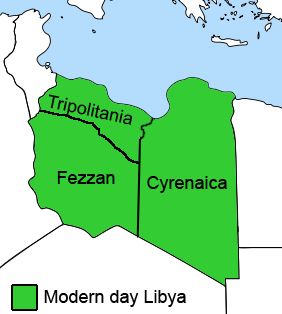It has been asked recently, why, after thousands of articles on Libya and the uprising, there has been almost nothing published about the Fezzan, the southern of the three regions of Libya. Every journalist has reported breathlessly on each skirmish and every village on the coast – from Benghazai in Cyrenaica to Tripoli in Tripolitania, but not a word on the Fezzan… why?
The short answer is: no one is protesting – they generally support the government. Absence of protest does not make for good copy in the New York Times or the Times of London. While this blog has posted a number of articles on Fezzan here and here, few others have.
Fezzan is the south-western region of Libya with a population of one-half million people (one-tenth of the country) living in the few habitable locations between expansive desert: in the north by the Ash-Shati Valley, in the west by the Irawan Valley and spots in the Tibesti Mountains near the Chad border.

Ottoman Provinces Of Present-day Libya
Many of the tribes in Fezzan stretch across the southern borders and many there have dual Chadian/ Libyan citizenships. The tribes do not conform to colonialist boundaries that the Italians (and Ottomans) used to create Libya (as do few nation-states in Africa). The two largest groups in the Fezzan are the Tuaregs and the Tebus.
The Tuareg people are Berbers (the largest group in Fezzan) and their population spans from southwest Libya through Niger, Algeria and Mali. In general they speak Tamasheq, rather than Arabic, and have historically been nomadic.

The black-skinned Tebu tribe extends from eastern Fezzan deep into Chad and somewhat into eastern Mali. They have been caught up in various disputes during the rebellion, mostly at the insistence of the ‘rebels’ that they were foreign African mercenaries. The acceptance of this rumor as fact has been denounced by Human Rights Watch. Confounding the issue has been the dual-citizens between Libya and Chad, and numbers of sub-Saharan migrant laborers that have many years ago taken up residence in Libya and now have Libyan citizenship.
There are many North Africans and sub-Saharans who have settled in Fezzan after Qaddafi’s open-boarder invitations to Africans and after his futile dallyings in conflicts in Chad and elsewhere. But Fezzan has benefited from Qaddafi’s pan-Africanism, and economic development.
“Recent growth here is associated instead with massive new irrigation facilities and with road-building and other infrastructural projects undertaken by the Libyan government. Some of this activity has been aimed at linking Libya more closely to sub-Saharan Africa, one of the cornerstones of Gaddafi’s ambitious foreign policy agenda.
“As of March 1, 2011, Fezzan remained firmly under the control of the Gaddafi regime, with no indication of rebel activity in any of its cities or towns.”
Time magazine quoted some Fezzan Gaddafi troops that had been sent to quell the uprising in Cyenaica:
“We were afraid to go out because we are dark-skinned and we thought they would think we’re mercenaries and attack us.”
And this from NowLebanon, which recognized Qaddafi’s opposition to racial discrimination against Tebu tribes:
“There are dark-skinned Libyans in the south of the country who are largely loyal to Qaddafi because he did take steps to end systematic discrimination against dark-skinned Libyans,” said Bouckaert.
And so, we hear little of this segment of modern Libya – it is remote, and most especially does not conform to the desired image of a population in revolt against a ‘tyrannical despot’.
.


